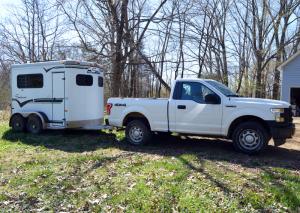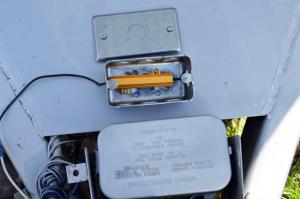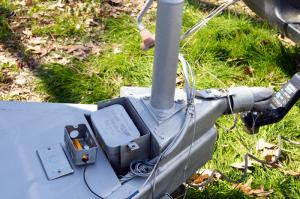By Tommy Brannon
My truck asked, “What trailer brakes?”
The new model trucks and cars are marvels of technology with lots of cool features, like back up cameras, information modules, display screens, memory seats/mirrors and blue tooth. In addition, there are plenty of safety features that we now take for granted: anti-lock brakes, stability control, smart tech side and front air bags, and anti-roll over protection. The engines and transmissions are much more sophisticated than in the past, more efficient, with more power and torque. Many of these features are computer controlled; in fact, a 2019 model truck has more computer technology than the space craft that landed on the moon. “Really?” asked my truck.
I encountered the challenge of this new technology when I recently purchased a new pickup truck and needed to set up the trailer brakes for my 1997 two horse bumper pull horse trailer. Trailer brake technology has not changed much since this trailer was built, but truck technology has change a lot.
Drum type electric trailer brakes consist of conventional brake shoes and brake drums that are activated by electro magnets, which grip a machined plate on the inside of the drum. The more current (amps) sent to the magnets, the harder it grips and, thus, the more the brakes engage. The current flow is regulated by the trailer brake controller. An electronic trailer brake controller senses the amount of brake pedal pressure, plus the inertia of the slowing truck and trailer, to modulate the amount of current being sent to the trailer brakes. The initial amount and maximum amount of current (gain) is set by the driver and can be adjusted as necessary.
On my previous trucks I had installed aftermarket brake controllers and had towed various bumper pull and gooseneck trailers without any issues. I decided with this new Ford F150 to get an original equipment (OE) controller designed by the manufacturer for the truck. This controller fits right into the dash. The controls are easily accessible and the trailer information and status are displayed in the instrument cluster. The controller is not “plug and play,” however. It has to be programmed into the system by the dealer, or a shop with the appropriate software tool. This is not unique to Ford. All of the new trucks have a similar system. The advantage to using the OE controller is that it integrates into the rest of the truck management system of engine, transmission shifting, anti-sway control, lights, and electrical continuity testing. The dash display will tell the driver, for example, if there is a light burned out on the trailer, what the set gain is, and how much braking force current is being applied. It will also tell the driver if the trailer electrical connection is intact, or if the trailer brakes are not working.
The first problem I had with my new rig wiring was that my older trailer had a six prong pin connecter and the new truck had a seven prong spade RV connecter. There are several adapters available on the aftermarket to fix this, but there is no standardization in the industry as to how the plugs are wired. As soon as I plugged it in, the brakes locked up on the trailer!
The adapter had instructions for alternate wiring options and Ford provides a plug wiring diagram right on the plug cover. After rewiring the adapter, the trailer brakes no longer locked up, but the dash display told me the trailer brakes were disconnected when I engaged the trailer brake manual override, although all of the lights on the trailer worked. I decided to update the trailer plug to the newer seven prong RV plug, but that did not solve the problem either. I knew the trailer brakes worked fine because they worked OK with my other trucks, and they had locked up when 12 volts were applied to the magnets. I added a 10 gauge additional ground wire to make sure the trailer had a good ground and tested the resistance, which showed to be 6.2 ohms. The system still wasn’t working properly.
What do you do in the 21st century when you have a mechanical problem that needs to be fixed? You go to Google or YouTube, of course, to see if anyone else has encountered this same problem. One problem with this approach: there is just about as much speculation and misinformation on the Internet about fixing a mechanical problem as there is about any other subject.
I reasoned that probably the most informed group about trailer brake issues and truck to trailer compatibility would be RV drivers, so I sought out some of their forums. Amongst all of the speculation and misinformation on the forums was a fellow who seemed very knowledgeable. He had encountered this problem and said that the newer OE brake controllers have a safety feature built into their software to make sure there is enough current to engage the trailer brakes. It tests resistance on the circuit in real-time to make sure there is a good connection. Corrosion on the connecter, a broken wire, or the connecter becoming unplugged would have too high resistance and the dash display would show no trailer brakes. Good information to know, particularly should this happen while you are hauling your horses.
The problem was that the normal resistance of the brake magnets (6.2 Ohms) was higher than the threshold resistance point of the brake controller to indicate insufficient current. I could not decrease the resistance in the brake magnets, so I decreased the whole circuit resistance and increased the current (amps) by wiring a 3 ohm resistor parallel in the circuit on the trailer. This decreased the overall resistance to 1.5 ohms and increased the current to the brake magnets. As it turns out, the resistor is readily available as a kit at just about any parts store because it is often necessary when installing LED turn signal lights on a vehicle or trailer that previously had incandescent bulbs. “Who knew?” asked my truck. So, I got to do the “I fixed it” dance! Good thing no one was watching – except my truck.
My truck asked, “What trailer brakes?”
The new model trucks and cars are marvels of technology with lots of cool features, like back up cameras, information modules, display screens, memory seats/mirrors and blue tooth. In addition, there are plenty of safety features that we now take for granted: anti-lock brakes, stability control, smart tech side and front air bags, and anti-roll over protection. The engines and transmissions are much more sophisticated than in the past, more efficient, with more power and torque. Many of these features are computer controlled; in fact, a 2019 model truck has more computer technology than the space craft that landed on the moon. “Really?” asked my truck.
I encountered the challenge of this new technology when I recently purchased a new pickup truck and needed to set up the trailer brakes for my 1997 two horse bumper pull horse trailer. Trailer brake technology has not changed much since this trailer was built, but truck technology has change a lot.
Drum type electric trailer brakes consist of conventional brake shoes and brake drums that are activated by electro magnets, which grip a machined plate on the inside of the drum. The more current (amps) sent to the magnets, the harder it grips and, thus, the more the brakes engage. The current flow is regulated by the trailer brake controller. An electronic trailer brake controller senses the amount of brake pedal pressure, plus the inertia of the slowing truck and trailer, to modulate the amount of current being sent to the trailer brakes. The initial amount and maximum amount of current (gain) is set by the driver and can be adjusted as necessary.
On my previous trucks I had installed aftermarket brake controllers and had towed various bumper pull and gooseneck trailers without any issues. I decided with this new Ford F150 to get an original equipment (OE) controller designed by the manufacturer for the truck. This controller fits right into the dash. The controls are easily accessible and the trailer information and status are displayed in the instrument cluster. The controller is not “plug and play,” however. It has to be programmed into the system by the dealer, or a shop with the appropriate software tool. This is not unique to Ford. All of the new trucks have a similar system. The advantage to using the OE controller is that it integrates into the rest of the truck management system of engine, transmission shifting, anti-sway control, lights, and electrical continuity testing. The dash display will tell the driver, for example, if there is a light burned out on the trailer, what the set gain is, and how much braking force current is being applied. It will also tell the driver if the trailer electrical connection is intact, or if the trailer brakes are not working.
The first problem I had with my new rig wiring was that my older trailer had a six prong pin connecter and the new truck had a seven prong spade RV connecter. There are several adapters available on the aftermarket to fix this, but there is no standardization in the industry as to how the plugs are wired. As soon as I plugged it in, the brakes locked up on the trailer!
The adapter had instructions for alternate wiring options and Ford provides a plug wiring diagram right on the plug cover. After rewiring the adapter, the trailer brakes no longer locked up, but the dash display told me the trailer brakes were disconnected when I engaged the trailer brake manual override, although all of the lights on the trailer worked. I decided to update the trailer plug to the newer seven prong RV plug, but that did not solve the problem either. I knew the trailer brakes worked fine because they worked OK with my other trucks, and they had locked up when 12 volts were applied to the magnets. I added a 10 gauge additional ground wire to make sure the trailer had a good ground and tested the resistance, which showed to be 6.2 ohms. The system still wasn’t working properly.
What do you do in the 21st century when you have a mechanical problem that needs to be fixed? You go to Google or YouTube, of course, to see if anyone else has encountered this same problem. One problem with this approach: there is just about as much speculation and misinformation on the Internet about fixing a mechanical problem as there is about any other subject.
I reasoned that probably the most informed group about trailer brake issues and truck to trailer compatibility would be RV drivers, so I sought out some of their forums. Amongst all of the speculation and misinformation on the forums was a fellow who seemed very knowledgeable. He had encountered this problem and said that the newer OE brake controllers have a safety feature built into their software to make sure there is enough current to engage the trailer brakes. It tests resistance on the circuit in real-time to make sure there is a good connection. Corrosion on the connecter, a broken wire, or the connecter becoming unplugged would have too high resistance and the dash display would show no trailer brakes. Good information to know, particularly should this happen while you are hauling your horses.
The problem was that the normal resistance of the brake magnets (6.2 Ohms) was higher than the threshold resistance point of the brake controller to indicate insufficient current. I could not decrease the resistance in the brake magnets, so I decreased the whole circuit resistance and increased the current (amps) by wiring a 3 ohm resistor parallel in the circuit on the trailer. This decreased the overall resistance to 1.5 ohms and increased the current to the brake magnets. As it turns out, the resistor is readily available as a kit at just about any parts store because it is often necessary when installing LED turn signal lights on a vehicle or trailer that previously had incandescent bulbs. “Who knew?” asked my truck. So, I got to do the “I fixed it” dance! Good thing no one was watching – except my truck.









